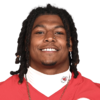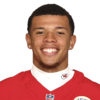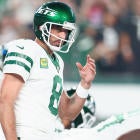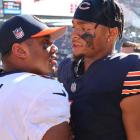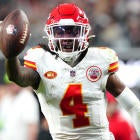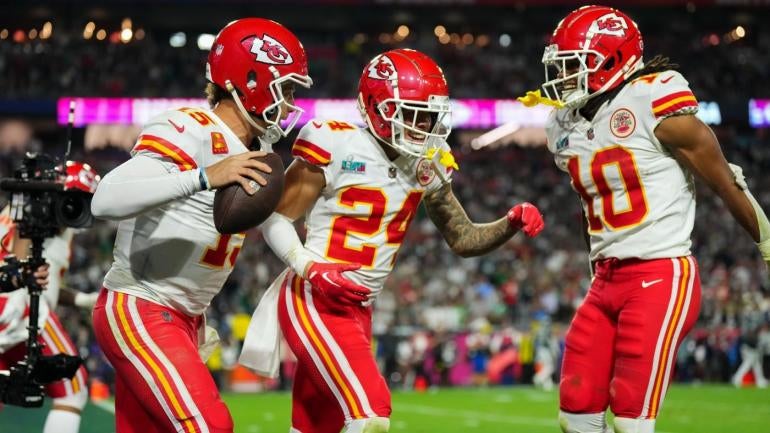
It will be a brand new world for Patrick Mahomes, Andy Reid and the Kansas City Chiefs on Thursday night, as star tight end Travis Kelce will miss the season-opener against the Detroit Lions with a bone bruise.
Kelce hasn't missed a game for injury since his 2013 rookie year and has missed just three games overall since: one each in 2017 and 2020 for rest purposes and one in 2021 for COVID-19. Since 2018, when Mahomes took over as Kansas City's full-time quarterback, Kelce has played nearly 200 offensive snaps more than any other skill-position player in the NFL.
Still, there's a decent sample size (683 offensive snaps to be exact) that includes Mahomes but not Kelce -- the situation the Chiefs face against the Lions to open the 2023 campaign. And we can draw some conclusions from those 683 plays.
Before we get there, though, it's important to know that this is a massive loss. Kelce is as important to his offense as any non-quarterback in the league. He's Mahomes' top target, matchup nightmare, red-zone stud, safety valve and go-to guy on extended plays ... all rolled into one. He's explosive before and after the catch, he's reliable, and he and Mahomes have a connection that numbers can't explain. But numbers can explain this:
Chiefs with Patrick Mahomes since 2018
| With Travis Kelce | Without Travis Kelce | |
|---|---|---|
| Yards per play | 6.7 | 5 |
| Yards per attempt | 8.2 | 7.1 |
| Yards per completion | 12.4 | 10.6 |
| Expected points added per play | 0.17 | 0.06 |
Here are three ways the Chiefs' attack could look different without Kelce. All of the notes below are since 2018 unless otherwise noted.
1. Pre-snap: More rushing, more RBs and more motion
The first big change might not be a wholly unexpected one. While his blocking skills have improved, Kelce is a future Hall of Famer for his receiving exploits. Over the past five years, the Chiefs have run the ball more than 58% of the time when Kelce isn't on the field with Mahomes compared to under 35% of the time when he is. Some of this is common sense -- the Chiefs lean more run-heavy when their best pass-catcher needs a breather -- and some of it is situational. In the 2021 contest Kelce missed for COVID-19, the Chiefs ran 35 times and passed only 30, but they were also ahead almost the entire game, a 36-10 win over the Steelers.
What's more interesting is the pre-snap changes. The Chiefs have had multiple backs on the field for under 5% of Mahomes' snaps with Kelce since 2018. That number skyrockets to more than 24% when Kelce hasn't been on the field with Mahomes. When Kelce has been on the field with Mahomes, the Chiefs line up in the shotgun over 82% of the time (64% when Kelce isn't in).
Furthermore, the Chiefs run pre-snap motion 57% of the time with Mahomes and Kelce in (up to 64% when Kelce isn't in). Again, this makes sense: Kelce is a superior talent who wins one-on-one matchups with a defender without the Chiefs needing any pre-snap clues. But when he's not on the field, the Chiefs like to open things up for other targets. Here's a play where Noah Gray -- who will have an expanded role should Kelce be out -- clears things out for Skyy Moore for an easy release and a first down.

Pick Six Newsletter
Crafted By The Best NFL Experts
Get the day's big stories + fun stuff you love like mock drafts, picks and power rankings.
Thanks for signing up!
Keep an eye on your inbox.
Sorry!
There was an error processing your subscription.
2. During the play: More targets out wide, but shorter throws
Kelce has garnered more targets than anyone not named Davante Adams and Stefon Diggs since 2018, so the targets swing massively when he's out.
Chiefs with Patrick Mahomes since 2018
| With Travis Kelce | Without Travis Kelce | |
|---|---|---|
| RB target pct | 17.1% | 20.7% |
| TE target pct | 30.4% | 14.2% |
| WR target pct | 49.6% | 59.6% |
As tight end targets naturally plummet, the wide receivers see the major boost. Without Kelce, Mahomes in particular favors his teammates lined up wide (40% target share compared to 36% when Kelce is on the field). The slot target share dips (34% to 28%) as a result.
Mahomes also gets the ball out faster and shorter without his top tight end. With Kelce on the field, Mahomes throws 43% of his passes in under 2.5 seconds. That figure jumps to 48% without Kelce on the field. Likewise, Mahomes' air yards per attempt drop precipitously from 8.3 with Kelce to 6.2 without Kelce. That has meant fewer explosive plays, but it's also meant fewer sacks and fewer big negative plays. It's a compromise the Chiefs wouldn't like to make -- part of what makes Mahomes great is his willingness to take risks both when trying to avoid pressure and after letting the ball go -- but it shows the bad plays might not be quite so bad.
3. How defenses might adjust: Less pressure coming at Mahomes and WRs, but more pressure on them to perform
When Mahomes and Kelce are both on the field, the Chiefs have faced a blitz on 18.7% of their plays. That drops to 15.1% when Kelce hasn't been on the field. The thinking seems to be that if you give Mahomes clean pockets, he and Kelce will pick you apart. Then again, they pick you apart even when Mahomes is pressured, but that's a different discussion. Overall, making things even somewhat off-rhythm for him can help the defense.
Since 2018, opponents have played press coverage against the Chiefs on 64% of passing when both Mahomes and Kelce have been on the field. That number drops to 53% when Kelce hasn't been on the field. So while Mahomes' receiving options may get more free releases, they'll have to prove they can actually win downfield or against individual matchup, something Kelce does as well as any tight end, ever.
Mahomes and Reid will certainly adjust to Kelce's availability (or lack there of). Those adjustments could be big ones, though, and it will pose a big challenge -- with not much time to solve it -- for one of the very best quarterback-coach duos in NFL history







